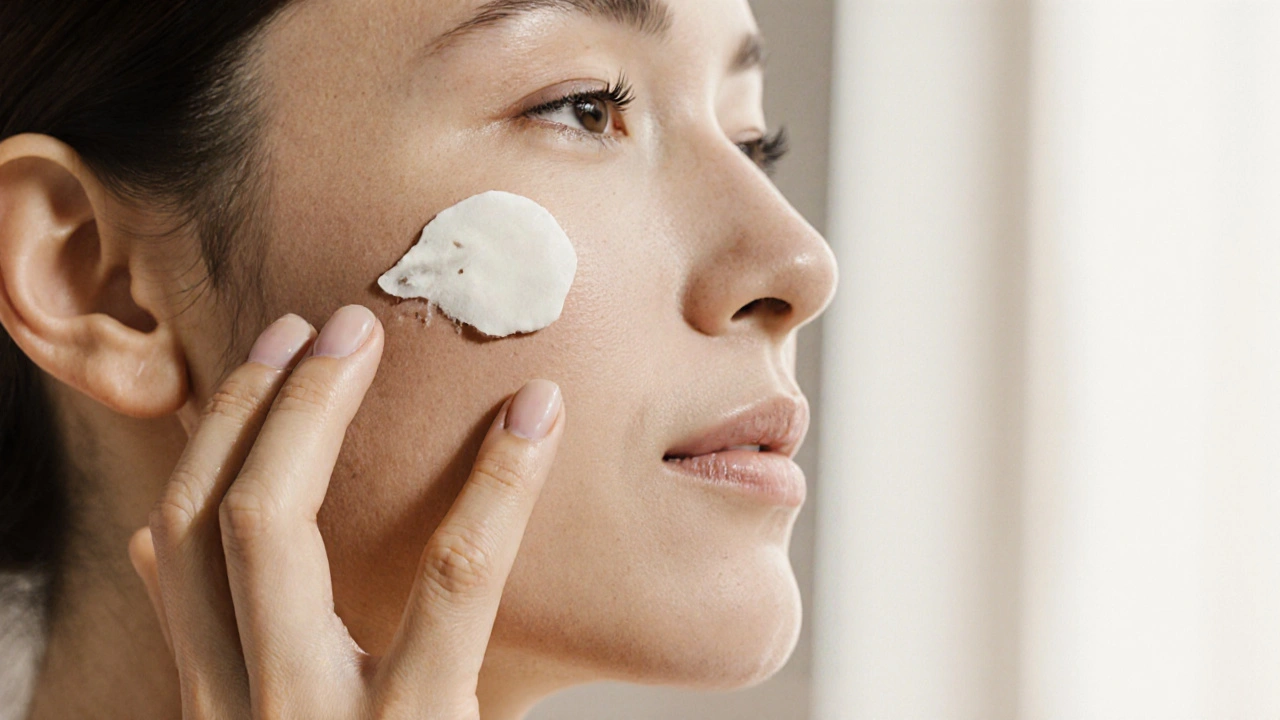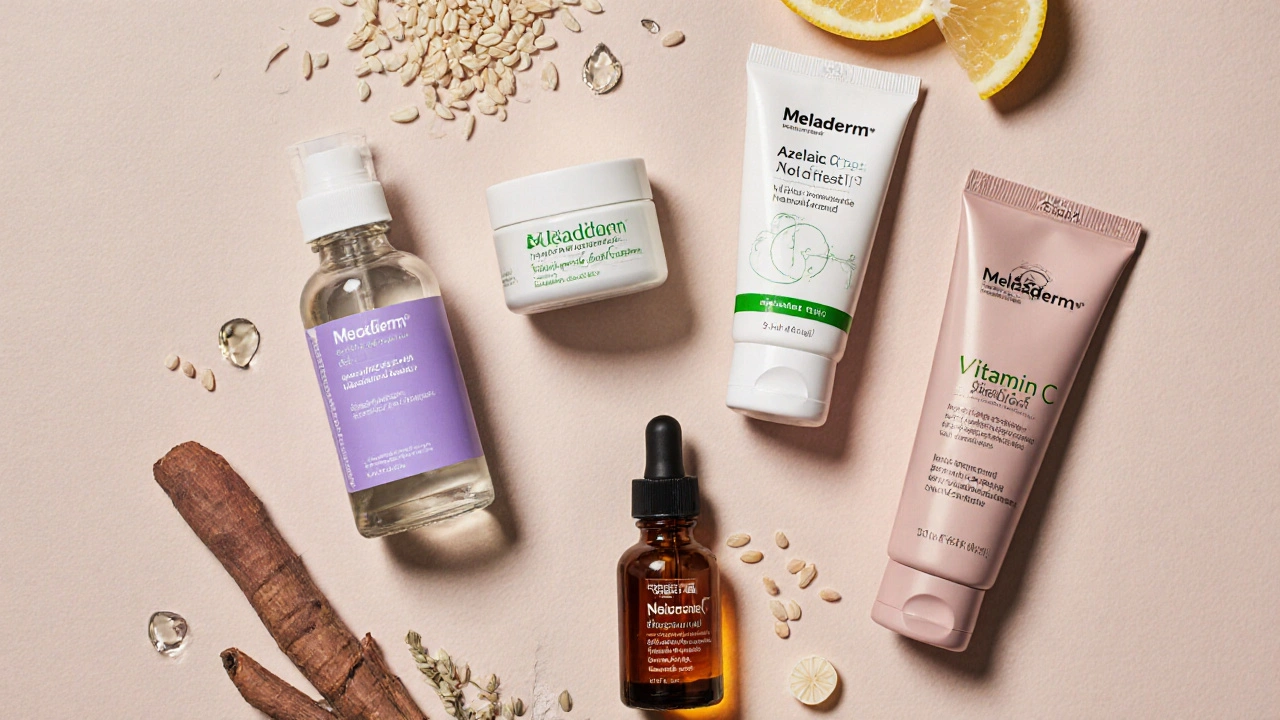
Answer a few questions to get a personalized recommendation based on the article's comparison of depigmenting creams.
Eukroma Cream is a topical depigmenting formulation that contains 2% hydroquinone, a classic skin‑lightening agent. It is marketed for melasma, post‑inflammatory hyperpigmentation, and age spots. The cream works by inhibiting the enzyme tyrosinase, which reduces melanin synthesis in melanocytes. Users typically apply a thin layer twice daily for up to 12 weeks, followed by a maintenance phase.
Hydroquinone is a phenolic compound that interferes with the oxidation of tyrosine to L‑DOPA, the rate‑limiting step in melanin production. Its concentration in over‑the‑counter products is limited to 2% in many markets, while prescription versions can reach 4% or higher. The strength of hydroquinone explains why Eukroma Cream often shows visible lightening in 4-6 weeks.
However, hydroquinone can trigger irritation, contact dermatitis, and-rarely-exogenous ochronosis, a permanent darkening of the skin. Because of these concerns, several countries have restricted its sale, prompting users to look for safer alternatives.
People switch from hydroquinone‑based creams for three main reasons:
Choosing the right alternative means balancing efficacy, safety, price, and skin‑type compatibility.
When you line up Eukroma Cream against other options, keep these checkpoints in mind:

Meladerm is a hydroquinone‑free cream that blends kojic acid, azelaic acid, arbutin, and licorice extract. The formulation targets melanin production via multiple pathways, delivering a gentler but slower brightening effect. Typical use is twice daily for 8-12 weeks.
Pros: Low irritation risk, suitable for dark‑skinned individuals, contains antioxidants.
Cons: Results appear after 6-8 weeks, price is higher than basic hydroquinone creams.
Azelaic acid (15%-20%) is a dicarboxylic acid that blocks tyrosinase and has anti‑inflammatory properties. It is often prescribed for rosacea and acne, but its depigmenting ability makes it a popular hydroquinone substitute.
Pros: Dual action for acne‑prone skin, excellent tolerability, FDA‑cleared.
Cons: May cause mild tingling, slower fade for deep melasma.
Kojic acid, derived from fermented rice, chelates copper ions needed for tyrosinase activity. Concentrations range from 1% to 4% in creams.
Pros: Natural origin, works well for post‑inflammatory marks.
Cons: Can be unstable in light, risk of contact dermatitis in very sensitive users.
L‑ascorbic acid (10%-20%) is a potent antioxidant that interferes with melanin formation and protects against UV‑induced oxidation. It is usually applied in the morning before sunscreen.
Pros: Brightens while providing anti‑aging benefits, easy to layer.
Cons: Requires stable formulation (pH <3.5), may cause stinging on compromised skin.
Niacinamide (5%-10%) reduces transfer of melanosomes to skin cells, while licorice root (glabridin) inhibits tyrosinase. The duo is favored for its soothing profile.
Pros: Very low irritation, suitable for daily use, improves barrier function.
Cons: Lightening effect is subtle; best for maintenance rather than aggressive fade.

| Product | Active(s) | Typical Concentration | Regulatory Status | Time to Noticeable Fade | Side‑Effect Risk | Price (US$/oz) |
|---|---|---|---|---|---|---|
| Eukroma Cream | Hydroquinone | 2% | OTC in many markets, prescription‑only in some EU countries | 4-6 weeks | Medium-high (irritation, ochronosis) | ≈$22 |
| Meladerm | Kojic Acid, Azelaic Acid, Arbutin, Licorice Extract | 1%-4% each | OTC worldwide | 6-8 weeks | Low (rare dermatitis) | ≈$30 |
| Azelaic Acid Gel | Azelaic Acid | 15%-20% | OTC in US, prescription in some regions | 6-10 weeks | Low (mild tingling) | ≈$35 |
| Kojic Acid Cream | Kojic Acid | 1%-4% | OTC | 8-12 weeks | Medium (possible dermatitis) | ≈$18 |
| Vitamin C Serum | L‑Ascorbic Acid | 10%-20% | OTC | 8-12 weeks | Low (stinging on compromised skin) | ≈$25 |
| Niacinamide + Licorice Combo | Niacinamide, Glabridin | 5%-10% Niacinamide, 0.5%‑1% Licorice | OTC | 10-14 weeks | Very low | ≈$20 |
If you need **fast, dramatic fading** and can tolerate occasional irritation, Eukroma Cream remains the go‑to choice. For **sensitive or darker skin tones**, Meladerm or the niacinamide‑licorice combo offers a safer route, though you’ll wait longer for results.
Those battling **acne‑related hyperpigmentation** will likely appreciate azelaic acid gel because it treats both concerns in one step. **Budget‑conscious shoppers** can start with a vitamin C serum or a basic kojic acid cream, both priced under $20 per ounce.
Regardless of the product, coupling the treatment with **broad‑spectrum SPF 30+** every morning prevents new spots and protects the lightened areas.
Yes, but apply vitamin C in the morning and Eukroma Cream at night. This separation reduces the chance of irritation while letting each ingredient work at its optimal pH.
New Zealand classifies hydroquinone as a prescription‑only medicine. Over‑the‑counter sales of products containing more than 0.5% are not permitted.
Most dermatologists recommend a maximum of 12 weeks of continuous hydroquinone use, followed by a maintenance phase with a milder agent like niacinamide or vitamin C.
Azelaic acid gel is often favored for facial melasma because it targets pigment while calming inflammation, which is common on the cheeks.
Kojic acid can cause contact dermatitis in people with very sensitive skin and may degrade when exposed to light. Storing the product in a dark container helps preserve potency.
Identify your primary goal-speed, safety, cost, or a blend of all three. Use the table above to shortlist two candidates that meet your criteria. Conduct a patch test, then commit to a 12‑week trial while protecting the skin with sunscreen. If you notice persistent irritation, switch to a gentler alternative like the niacinamide‑licorice combo.
Remember, brightening is a marathon, not a sprint. Consistency, sun protection, and realistic expectations will get you the clear, even tone you’re after.
5 Responses
Hydroquinone works fast but it can really irritate sensitive skin 😬
Honestly, if you’re looking for something gentler, meladerm does the trick without the burn :) just keep it consistent.
When you compare Eukroma Cream to the hydroquinone‑free options, the first thing to notice is the trade‑off between speed and safety. Eukroma’s 2% hydroquinone will often give visible lightening within four to six weeks, which is impressive for people with stubborn melasma. However, that rapid action comes with a higher chance of irritation, contact dermatitis, and in rare cases, exogenous ochronosis. For those with a history of sensitive skin, even a mild rash can set back treatment progress because you’ll have to stop using the product. The alternatives like Meladerm, azelaic acid gel, and kojic acid cream avoid hydroquinone altogether, so their side‑effect profiles are generally milder. Meladerm combines kojic acid, arbutin, and licorice extract, targeting melanin production through several pathways rather than a single enzyme block. This multi‑target approach means results appear more gradually – typically after six to eight weeks – but the skin’s barrier stays intact. Azelaic acid, besides inhibiting tyrosinase, also has anti‑inflammatory properties, making it a solid pick for acne‑prone folks who also want to fade dark spots. It’s FDA‑cleared and usually tolerated well, with only a mild tingling sensation in some users. Kojic acid is derived from fermented rice and works by chelating copper ions needed for tyrosinase activity; it’s effective for post‑inflammatory hyperpigmentation but can be unstable when exposed to light, so packaging matters. Vitamin C serums add antioxidant protection and brighten the skin, yet they’re not as potent as hydroquinone for deep melasma, so they’re best for maintenance or early‑stage discoloration. Cost is another factor – Eukroma Cream is often cheaper per ounce than the branded alternatives, but the price difference narrows when you factor in the need for sunscreen and possible skin‑care adjuncts. Finally, regulatory status varies by country; hydroquinone is restricted or prescription‑only in many places, whereas the other actives are generally OTC. Bottom line: pick the product that aligns with your skin’s tolerance, how quickly you need results, and your comfort with the ingredient’s regulatory standing.
While the thorough rundown is appreciated, one must also question the underlying bias towards “natural” ingredients that often lack robust clinical data. The market loves to hype licorice or kojic acid without acknowledging batch‑to‑batch variability, which can lead to inconsistent outcomes. Moreover, the claim that hydroquinone is merely “fast” overlooks the decades of dermatological literature documenting its long‑term risks. A truly evidence‑based approach would prioritize double‑blind studies over anecdotal enthusiasm.
Regulators have grounded hydroquinone for a reason – it’s a nightmare for people with eczema or rosacea, and the government isn’t stupid enough to let that slide.